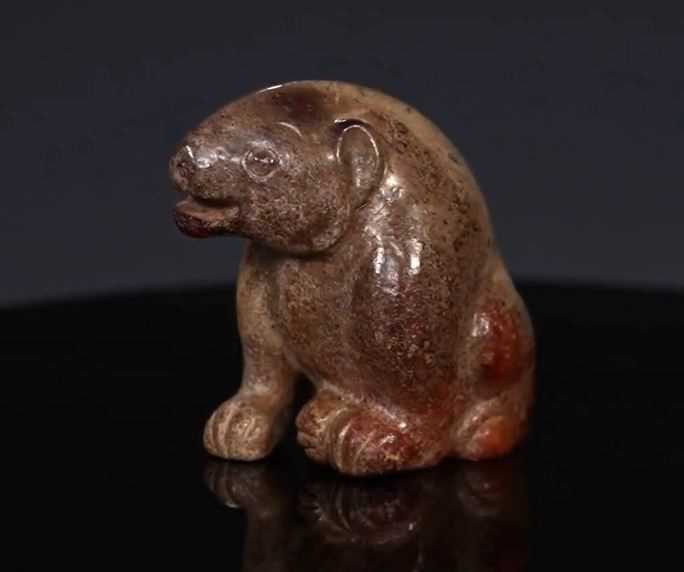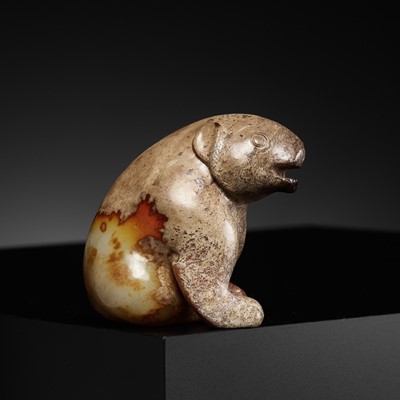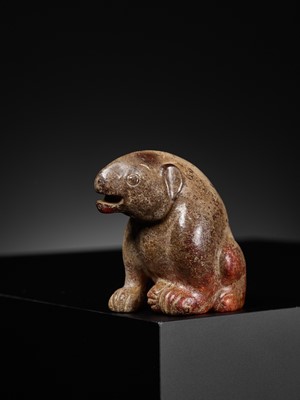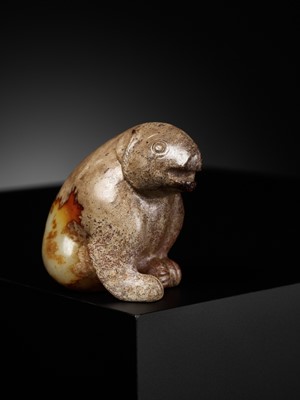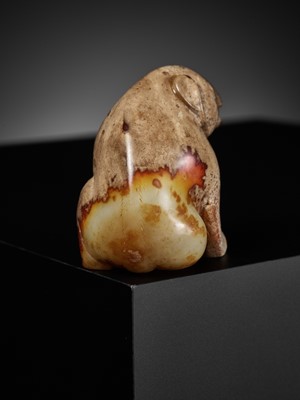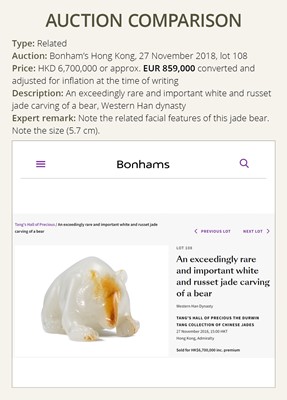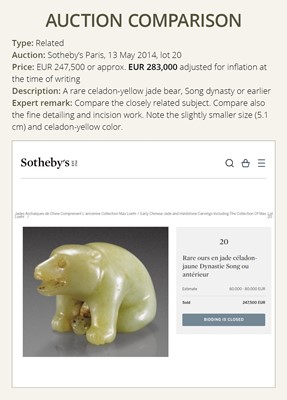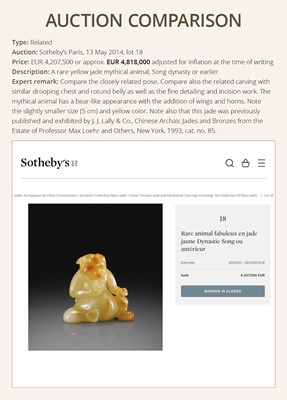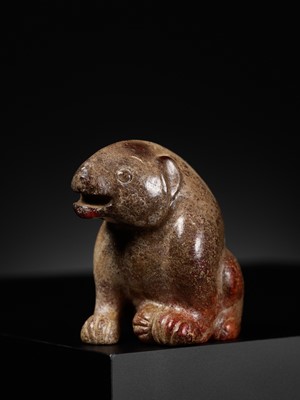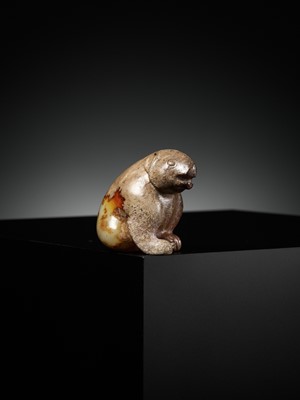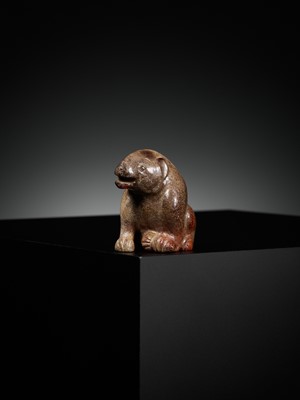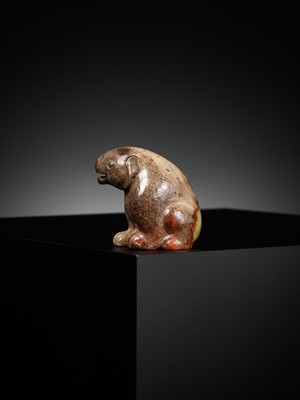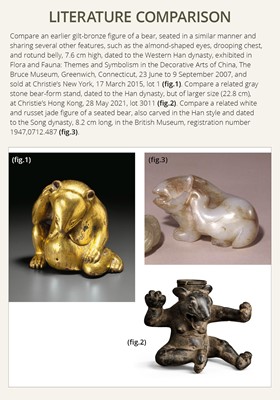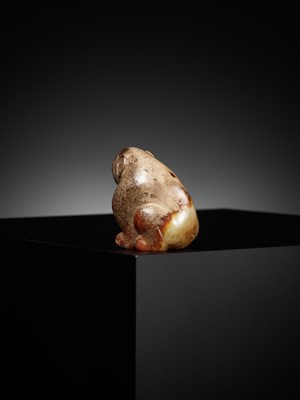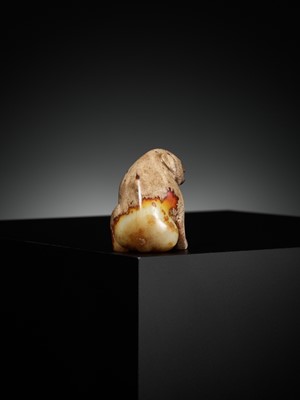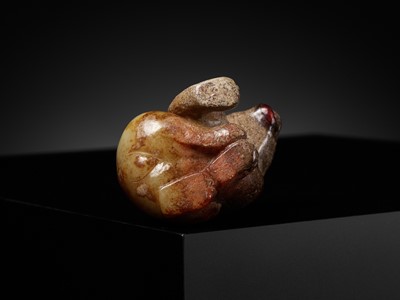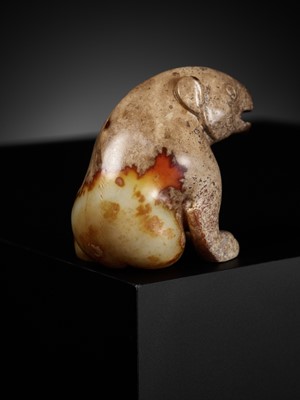11th Oct, 2023 11:00
THREE-DAY AUCTION - Fine Chinese Art / 中國藝術集珍 / Buddhism & Hinduism
22
AN EXCEPTIONAL YELLOW JADE FIGURE OF A BEAR, HUANGXIONG, HAN DYNASTY, CHINA, 202 BC – 220 AD
漢代黃玉熊
Sold for €9,750
including Buyer's Premium
Expert’s note: At peace with itself and the world, the bear appears to be enjoying the moment and is wholly lacking the ferocity that typifies most Han-dynasty representations of bears, tigers, and other wild beasts, marking this as an astonishingly rare and naturalistic sculpture. The stone is calcified throughout, but a single patch of the original jade fades from a fine yellow tone through a deep orange into a remarkable cinnabar red, exemplifying the fact that jade can have almost any color.
Special care seems to have been given to this jade bear after its rediscovery. Not only has the stone been finely polished by a dedicated craftsman after it’s retrieval from the earth - extensive soil encrustations remain visible all over the exterior – but it was also repaired with a neatly lacquered replacement piece meticulously inserted to the lower jaw. This lacquer repair, likely Japanese in origin, interplays nicely with the red shades on the left hind leg of the bear. The conclusion of this author is that the present lot was probably found at some point around the 18th century, where it was treated as described above, and eventually brought to Japan, where the red lacquer repair has been carried out. From there it made its way to Europe, probably at some point in the earlier part of the 20th century. Also note that until 1945, the German Reich and the Japanese Empire were close allies, exchanging on many different levels of culture.
The small yet compelling sculpture represents a plump bear seated on its haunches in a moment of repose. The round eyes gazing forward and flanking the nose, the forehead with a central line below the attentively raised ears, the spine extending to the short, peach-form tail with very fine incised lines on either side, the haunches well rounded and extending to the muscular legs and clawed paws, with one tucked underneath. The opaque jade is of a deep yellow hue with orange, red and russet shades, covered almost entirely in ancient calcification.
Provenance: From a German private estate, by repute acquired by an unknown ancestor long time ago and in the family ever since.
Condition: Good condition, commensurate with age, displaying exceptionally well. Signs of wear and weathering, losses, nicks, calcification and encrustation as a result of an extended period of burial. An ancient red lacquer ‘Kintsugi’ style repair to the lower jaw, most likely applied in Japan a long time ago. The stone with natural inclusions and fissures, some of which may have developed into small hairline cracks over time. The calcification also covers most of the incision work, which becomes apparent from looking at the tail which is not completely calcified.
Weight: 212 g
Dimensions: Height 6.6 cm
Please click here to read the full description
The bear has been a popular totemic emblem in China since ancient times. China's foundation myths hold that the legendary Yellow Emperor, or Huang Di, early on lived with his tribe in the northwest, presumably in modern Shanxi Province, but then later migrated to Zhuolu, in present-day Hebei Province, where he became a farmer and tamed six different types of ferocious beasts, including the bear, or xiong, with which the Yellow Emperor ever since has been linked. According to legend, Gun — said to have been the great-grandson of the Yellow Emperor and the father of Yu the Great, or Da Yu — stole a special soil with which he planned to build dikes in an attempt to control the Yellow River's constantly recurring and devastating floods. He failed in his mission, however, and as punishment for his theft, he was killed by Zhurong, the God of Fire. Gun's corpse turned into a yellow bear, or huangxiong, and jumped into a pool. A while later, a golden bear, alternatively said to be a golden dragon, emerged from the corpse's stomach and ascended into heaven, where the Yellow Emperor instructed it to complete his father's work in taming the Yellow River's waters. That bear turned out to be Da Yu, who — according to popular belief — heroically controlled the floods and became the mythological forefather of China's Xia dynasty. Therefore, the bear has been prominently associated with legendary rulers and Chinese national foundation myths since the earliest times.
Bears are native to China, their presence there known since antiquity. They were kept in Han imperial zoos and parks, where the emperor and his entourage enjoyed watching them in performance or in combat with other animals. On the other hand, they were perceived as enlightened creatures and it was believed that they resided in spiritual mountains and possessed the ability to intermediate between heaven and earth. Bears have also been linked with military prowess, shamanism, and immortality. As a corollary, it might be noted that the words for 'bear' and 'virility' are exact homonyms, pronounced xiong. According to the 'Rites of Zhou', Zhou Li, edited during the Han dynasty, bears were employed in exorcism rituals, their skin worn over the head of the performer who, holding a lance and a shield, led the officials to perform the Seasonal Exorcism by searching through houses and driving away pestilences. See J. Lagerway, Early Chinese Religion. Part One, Shang through Han (1250 BC-220 AD), Boston, 2008, page 287.
In ancient China, immortality was often considered the ultimate pursuit for royalty. The First Emperor who united the country in 221 BC is known to have sent expeditions into the Eastern Sea in search of Penglai, a mountainous island shrouded in a mysterious cloud, which at the time was believed to be the home of immortals, where elixirs of immortality could be retrieved. Once every 99th year, an immortal from this mysterious island would descend to the earthly realm and bestow immortality upon a select few. These immortals were believed to take the form of carved jade animals, for example bears.
Jade was the only material in which these mythological epitomes were believed to exist. This conviction probably stems from the near-indestructible quality of the mineral, which would make such a carving outlive every human being. When inhabited by an immortal, the jade would have looked almost fully translucent, especially when held against strong moonlight. According to ancient creed, the owner of such a magical jade animal was ensured an extended life. By having everyday contact with the object through rubbing its surface, the power of the inhabiting immortal would slowly be transferred to its owner. Highly sought after by the rich and wealthy, a jade animal as such was extremely rare and thus widely copied throughout Chinese history, particularly during the Song and Ming dynasties.
Evidence of this rich tradition of craftsmanship has been transmitted down through a small number of exquisite carvings, of which the present jade bear is a fine example. The craftsman has made good use of the lustrous colored stone in which the contours have been so skillfully and compactly utilized to depict the form of a seated bear. While it is superbly rendered, it lacks some of the ferocity of the earliest Han examples, being of a more benign appearance, thus pointing to a date closer to the end of the dynasty, when ancient archaic styles were slowly but surely replaced by more natural depictions, which today are among some of the most marvelous carvings of these animals.
Literature comparison:
Compare an earlier gilt-bronze figure of a bear, seated in a similar manner and sharing several other features, such as the almond-shaped eyes, drooping chest, and rotund belly, 7.6 cm high, dated to the Western Han dynasty, exhibited in Flora and Fauna: Themes and Symbolism in the Decorative Arts of China, The Bruce Museum, Greenwich, Connecticut, 23 June to 9 September 2007, and sold at Christie’s New York, 17 March 2015, lot 1. Compare a related gray stone bear-form stand, dated to the Han dynasty, but of larger size (22.8 cm), at Christie’s Hong Kong, 28 May 2021, lot 3011. Compare a related white and russet jade figure of a seated bear, also carved in the Han style and dated to the Song dynasty, 8.2 cm long, in the British Museum, registration number 1947,0712.487.
Auction result comparison:
Type: Related
Auction: Bonhams Hong Kong, 27 November 2018, lot 108
Price: HKD 6,700,000 or approx. EUR 859,000 converted and adjusted for inflation at the time of writing
Description: An exceedingly rare and important white and russet jade carving of a bear, Western Han dynasty
Expert remark: Note the related facial features of this jade bear. Note the size (5.7 cm).
Auction result comparison:
Type: Related
Auction: Sotheby’s Paris, 13 May 2014, lot 20
Price: EUR 247,500 or approx. EUR 283,000 adjusted for inflation at the time of writing
Description: A rare celadon-yellow jade bear, Song dynasty or earlier
Expert remark: Compare the closely related subject. Compare also the fine detailing and incision work. Note the slightly smaller size (5.1 cm) and celadon-yellow color.
Auction result comparison:
Type: Related
Auction: Sotheby’s Paris, 13 May 2014, lot 18
Price: EUR 4,207,500 or approx. EUR 4,818,000 adjusted for inflation at the time of writing
Description: A rare yellow jade mythical animal, Song dynasty or earlier
Expert remark: Compare the closely related pose. Compare also the related carving with similar drooping chest and rotund belly as well as the fine detailing and incision work. The mythical animal has a bear-like appearance with the addition of wings and horns. Note the slightly smaller size (5 cm) and yellow color. Note also that this jade was previously published and exhibited by J. J. Lally & Co., Chinese Archaic Jades and Bronzes from the Estate of Professor Max Loehr and Others, New York, 1993, cat. no. 85.
点此阅读中文翻译 (Chinese Translation)
漢代黃玉熊
玉雕一隻坐著休息的胖熊,圓圓的眼睛平時前方,前額中央有一條線,耳朵竪起,桃形短尾巴,腰部圓潤,延伸到臀部。腿部肌肉發達,有爪子,周身光素。不透明的玉呈深黃色,帶有橙色、紅色和黃褐色紋理,鈣化層。
來源:來自德國私人收藏,據説很久以前由一位不知名的祖先收藏,並從此在家族中保存。
品相:品相良好,有磨損和風化、損失、刻痕、鈣化和結殼的跡象。 一種紅漆金繼修復下顎,具有天然絮狀物和裂隙的玉石,其中一些可能隨著時間的推移發展成細小的裂紋。 鈣化覆蓋了大部分雕刻線條,這可以從未完全鈣化的尾部明顯看出。
重量:212 克
尺寸:高 6.6 厘米
熊在漢代是祥瑞威武之獸。熊與漢代的思想觀念、熊圖騰信仰等密不可分。從民俗文化意義上講,它們皆具有驅邪避惡、保護墓主人靈魂不受侵擾、肉體不受侵害的作用,最終目的是説明墓主人升入仙界。
文獻比較:
比較早期的一件西漢鎏金銅熊像,坐姿相似,其他特徵也有相似之處,如杏仁眼,下垂的胸部,圓腹,高7.6厘米,見《Flora and Fauna: Themes and Symbolism in the Decorative Arts of China》,Bruce博物館,康涅狄格州格林威治,2007年6月23日至9月9日,售於紐約佳士得,2015年3月17日,lot 1。比較一件相近的漢代灰色石熊,尺寸較大(22.8厘米),見香港佳士得,2021年5月28日,lot 3011。比較一件相近的漢代至宋代白玉留皮坐熊,長8.2厘米,藏於大英博物館,館藏編號1947,0712.487。
拍賣結果比較:
形制:相近
拍賣:香港邦翰斯,2018年11月27日,lot 108
價格:HKD 6,700,000(相當於今日EUR 859,000)
描述:西漢白玉雕熊
專家評論:請注意相近的面部表情。請注意尺寸 (5.7 釐米)。
拍賣結果比較:
形制:相近
拍賣:巴黎蘇富比,2014年5月13日,lot 20
價格:EUR 247,500(相當於今日EUR 283,000)
描述:宋或更早期黃青玉熊
專家評論:比較非常相近的主題。比較雕刻細節。請注意尺寸較小 (5.1 釐米) 和青黃玉顏色。
拍賣結果比較:
形制:相近
拍賣:巴黎蘇富比,2014年5月13日,lot 18
價格:EUR 4,207,500(相當於今日EUR 4,818,000)
描述:宋或更早期黃玉神獸
專家評論:比較非常相近的姿勢。比較相近的雕刻有相似的下垂胸部和圓腹,以及精細的細節和切口工作。這種神話動物具有像熊一樣的外觀,並帶有翅膀和角。請注意尺寸較小 (5 釐米) 和黃玉。請注意,這件玉器之前由 J. J. Lally & Co. 出版並展出過,《Chinese Archaic Jades and Bronzes from the Estate of Professor Max Loehr and Others》,紐約,1993 年,編號85。
Expert’s note: At peace with itself and the world, the bear appears to be enjoying the moment and is wholly lacking the ferocity that typifies most Han-dynasty representations of bears, tigers, and other wild beasts, marking this as an astonishingly rare and naturalistic sculpture. The stone is calcified throughout, but a single patch of the original jade fades from a fine yellow tone through a deep orange into a remarkable cinnabar red, exemplifying the fact that jade can have almost any color.
Special care seems to have been given to this jade bear after its rediscovery. Not only has the stone been finely polished by a dedicated craftsman after it’s retrieval from the earth - extensive soil encrustations remain visible all over the exterior – but it was also repaired with a neatly lacquered replacement piece meticulously inserted to the lower jaw. This lacquer repair, likely Japanese in origin, interplays nicely with the red shades on the left hind leg of the bear. The conclusion of this author is that the present lot was probably found at some point around the 18th century, where it was treated as described above, and eventually brought to Japan, where the red lacquer repair has been carried out. From there it made its way to Europe, probably at some point in the earlier part of the 20th century. Also note that until 1945, the German Reich and the Japanese Empire were close allies, exchanging on many different levels of culture.
The small yet compelling sculpture represents a plump bear seated on its haunches in a moment of repose. The round eyes gazing forward and flanking the nose, the forehead with a central line below the attentively raised ears, the spine extending to the short, peach-form tail with very fine incised lines on either side, the haunches well rounded and extending to the muscular legs and clawed paws, with one tucked underneath. The opaque jade is of a deep yellow hue with orange, red and russet shades, covered almost entirely in ancient calcification.
Provenance: From a German private estate, by repute acquired by an unknown ancestor long time ago and in the family ever since.
Condition: Good condition, commensurate with age, displaying exceptionally well. Signs of wear and weathering, losses, nicks, calcification and encrustation as a result of an extended period of burial. An ancient red lacquer ‘Kintsugi’ style repair to the lower jaw, most likely applied in Japan a long time ago. The stone with natural inclusions and fissures, some of which may have developed into small hairline cracks over time. The calcification also covers most of the incision work, which becomes apparent from looking at the tail which is not completely calcified.
Weight: 212 g
Dimensions: Height 6.6 cm
Please click here to read the full description
The bear has been a popular totemic emblem in China since ancient times. China's foundation myths hold that the legendary Yellow Emperor, or Huang Di, early on lived with his tribe in the northwest, presumably in modern Shanxi Province, but then later migrated to Zhuolu, in present-day Hebei Province, where he became a farmer and tamed six different types of ferocious beasts, including the bear, or xiong, with which the Yellow Emperor ever since has been linked. According to legend, Gun — said to have been the great-grandson of the Yellow Emperor and the father of Yu the Great, or Da Yu — stole a special soil with which he planned to build dikes in an attempt to control the Yellow River's constantly recurring and devastating floods. He failed in his mission, however, and as punishment for his theft, he was killed by Zhurong, the God of Fire. Gun's corpse turned into a yellow bear, or huangxiong, and jumped into a pool. A while later, a golden bear, alternatively said to be a golden dragon, emerged from the corpse's stomach and ascended into heaven, where the Yellow Emperor instructed it to complete his father's work in taming the Yellow River's waters. That bear turned out to be Da Yu, who — according to popular belief — heroically controlled the floods and became the mythological forefather of China's Xia dynasty. Therefore, the bear has been prominently associated with legendary rulers and Chinese national foundation myths since the earliest times.
Bears are native to China, their presence there known since antiquity. They were kept in Han imperial zoos and parks, where the emperor and his entourage enjoyed watching them in performance or in combat with other animals. On the other hand, they were perceived as enlightened creatures and it was believed that they resided in spiritual mountains and possessed the ability to intermediate between heaven and earth. Bears have also been linked with military prowess, shamanism, and immortality. As a corollary, it might be noted that the words for 'bear' and 'virility' are exact homonyms, pronounced xiong. According to the 'Rites of Zhou', Zhou Li, edited during the Han dynasty, bears were employed in exorcism rituals, their skin worn over the head of the performer who, holding a lance and a shield, led the officials to perform the Seasonal Exorcism by searching through houses and driving away pestilences. See J. Lagerway, Early Chinese Religion. Part One, Shang through Han (1250 BC-220 AD), Boston, 2008, page 287.
In ancient China, immortality was often considered the ultimate pursuit for royalty. The First Emperor who united the country in 221 BC is known to have sent expeditions into the Eastern Sea in search of Penglai, a mountainous island shrouded in a mysterious cloud, which at the time was believed to be the home of immortals, where elixirs of immortality could be retrieved. Once every 99th year, an immortal from this mysterious island would descend to the earthly realm and bestow immortality upon a select few. These immortals were believed to take the form of carved jade animals, for example bears.
Jade was the only material in which these mythological epitomes were believed to exist. This conviction probably stems from the near-indestructible quality of the mineral, which would make such a carving outlive every human being. When inhabited by an immortal, the jade would have looked almost fully translucent, especially when held against strong moonlight. According to ancient creed, the owner of such a magical jade animal was ensured an extended life. By having everyday contact with the object through rubbing its surface, the power of the inhabiting immortal would slowly be transferred to its owner. Highly sought after by the rich and wealthy, a jade animal as such was extremely rare and thus widely copied throughout Chinese history, particularly during the Song and Ming dynasties.
Evidence of this rich tradition of craftsmanship has been transmitted down through a small number of exquisite carvings, of which the present jade bear is a fine example. The craftsman has made good use of the lustrous colored stone in which the contours have been so skillfully and compactly utilized to depict the form of a seated bear. While it is superbly rendered, it lacks some of the ferocity of the earliest Han examples, being of a more benign appearance, thus pointing to a date closer to the end of the dynasty, when ancient archaic styles were slowly but surely replaced by more natural depictions, which today are among some of the most marvelous carvings of these animals.
Literature comparison:
Compare an earlier gilt-bronze figure of a bear, seated in a similar manner and sharing several other features, such as the almond-shaped eyes, drooping chest, and rotund belly, 7.6 cm high, dated to the Western Han dynasty, exhibited in Flora and Fauna: Themes and Symbolism in the Decorative Arts of China, The Bruce Museum, Greenwich, Connecticut, 23 June to 9 September 2007, and sold at Christie’s New York, 17 March 2015, lot 1. Compare a related gray stone bear-form stand, dated to the Han dynasty, but of larger size (22.8 cm), at Christie’s Hong Kong, 28 May 2021, lot 3011. Compare a related white and russet jade figure of a seated bear, also carved in the Han style and dated to the Song dynasty, 8.2 cm long, in the British Museum, registration number 1947,0712.487.
Auction result comparison:
Type: Related
Auction: Bonhams Hong Kong, 27 November 2018, lot 108
Price: HKD 6,700,000 or approx. EUR 859,000 converted and adjusted for inflation at the time of writing
Description: An exceedingly rare and important white and russet jade carving of a bear, Western Han dynasty
Expert remark: Note the related facial features of this jade bear. Note the size (5.7 cm).
Auction result comparison:
Type: Related
Auction: Sotheby’s Paris, 13 May 2014, lot 20
Price: EUR 247,500 or approx. EUR 283,000 adjusted for inflation at the time of writing
Description: A rare celadon-yellow jade bear, Song dynasty or earlier
Expert remark: Compare the closely related subject. Compare also the fine detailing and incision work. Note the slightly smaller size (5.1 cm) and celadon-yellow color.
Auction result comparison:
Type: Related
Auction: Sotheby’s Paris, 13 May 2014, lot 18
Price: EUR 4,207,500 or approx. EUR 4,818,000 adjusted for inflation at the time of writing
Description: A rare yellow jade mythical animal, Song dynasty or earlier
Expert remark: Compare the closely related pose. Compare also the related carving with similar drooping chest and rotund belly as well as the fine detailing and incision work. The mythical animal has a bear-like appearance with the addition of wings and horns. Note the slightly smaller size (5 cm) and yellow color. Note also that this jade was previously published and exhibited by J. J. Lally & Co., Chinese Archaic Jades and Bronzes from the Estate of Professor Max Loehr and Others, New York, 1993, cat. no. 85.
点此阅读中文翻译 (Chinese Translation)
漢代黃玉熊
玉雕一隻坐著休息的胖熊,圓圓的眼睛平時前方,前額中央有一條線,耳朵竪起,桃形短尾巴,腰部圓潤,延伸到臀部。腿部肌肉發達,有爪子,周身光素。不透明的玉呈深黃色,帶有橙色、紅色和黃褐色紋理,鈣化層。
來源:來自德國私人收藏,據説很久以前由一位不知名的祖先收藏,並從此在家族中保存。
品相:品相良好,有磨損和風化、損失、刻痕、鈣化和結殼的跡象。 一種紅漆金繼修復下顎,具有天然絮狀物和裂隙的玉石,其中一些可能隨著時間的推移發展成細小的裂紋。 鈣化覆蓋了大部分雕刻線條,這可以從未完全鈣化的尾部明顯看出。
重量:212 克
尺寸:高 6.6 厘米
熊在漢代是祥瑞威武之獸。熊與漢代的思想觀念、熊圖騰信仰等密不可分。從民俗文化意義上講,它們皆具有驅邪避惡、保護墓主人靈魂不受侵擾、肉體不受侵害的作用,最終目的是説明墓主人升入仙界。
文獻比較:
比較早期的一件西漢鎏金銅熊像,坐姿相似,其他特徵也有相似之處,如杏仁眼,下垂的胸部,圓腹,高7.6厘米,見《Flora and Fauna: Themes and Symbolism in the Decorative Arts of China》,Bruce博物館,康涅狄格州格林威治,2007年6月23日至9月9日,售於紐約佳士得,2015年3月17日,lot 1。比較一件相近的漢代灰色石熊,尺寸較大(22.8厘米),見香港佳士得,2021年5月28日,lot 3011。比較一件相近的漢代至宋代白玉留皮坐熊,長8.2厘米,藏於大英博物館,館藏編號1947,0712.487。
拍賣結果比較:
形制:相近
拍賣:香港邦翰斯,2018年11月27日,lot 108
價格:HKD 6,700,000(相當於今日EUR 859,000)
描述:西漢白玉雕熊
專家評論:請注意相近的面部表情。請注意尺寸 (5.7 釐米)。
拍賣結果比較:
形制:相近
拍賣:巴黎蘇富比,2014年5月13日,lot 20
價格:EUR 247,500(相當於今日EUR 283,000)
描述:宋或更早期黃青玉熊
專家評論:比較非常相近的主題。比較雕刻細節。請注意尺寸較小 (5.1 釐米) 和青黃玉顏色。
拍賣結果比較:
形制:相近
拍賣:巴黎蘇富比,2014年5月13日,lot 18
價格:EUR 4,207,500(相當於今日EUR 4,818,000)
描述:宋或更早期黃玉神獸
專家評論:比較非常相近的姿勢。比較相近的雕刻有相似的下垂胸部和圓腹,以及精細的細節和切口工作。這種神話動物具有像熊一樣的外觀,並帶有翅膀和角。請注意尺寸較小 (5 釐米) 和黃玉。請注意,這件玉器之前由 J. J. Lally & Co. 出版並展出過,《Chinese Archaic Jades and Bronzes from the Estate of Professor Max Loehr and Others》,紐約,1993 年,編號85。
Zacke Live Online Bidding
Our online bidding platform makes it easier than ever to bid in our auctions! When you bid through our website, you can take advantage of our premium buyer's terms without incurring any additional online bidding surcharges.
To bid live online, you'll need to create an online account. Once your account is created and your identity is verified, you can register to bid in an auction up to 12 hours before the auction begins.
Intended Spend and Bid Limits
When you register to bid in an online auction, you will need to share your intended maximum spending budget for the auction. We will then review your intended spend and set a bid limit for you. Once you have pre-registered for a live online auction, you can see your intended spend and bid limit by going to 'Account Settings' and clicking on 'Live Bidding Registrations'.
Your bid limit will be the maximum amount you can bid during the auction. Your bid limit is for the hammer price and is not affected by the buyer’s premium and VAT. For example, if you have a bid limit of €1,000 and place two winning bids for €300 and €200, then you will only be able to bid €500 for the rest of the auction. If you try to place a bid that is higher than €500, you will not be able to do so.
Online Absentee and Telephone Bids
You can now leave absentee and telephone bids on our website!
Absentee Bidding
Once you've created an account and your identity is verified, you can leave your absentee bid directly on the lot page. We will contact you when your bids have been confirmed.
Telephone Bidding
Once you've created an account and your identity is verified, you can leave telephone bids online. We will contact you when your bids have been confirmed.
Classic Absentee and Telephone Bidding Form
You can still submit absentee and telephone bids by email or fax if you prefer. Simply fill out the Absentee Bidding/Telephone bidding form and return it to us by email at office@zacke.at or by fax at +43 (1) 532 04 52 20. You can download the PDF from our Upcoming Auctions page.
How-To Guides
How to Create Your Personal Zacke Account
How to Register to Bid on Zacke Live
How to Leave Absentee Bids Online
How to Leave Telephone Bids Online
中文版本的操作指南
创建新账号
注册Zacke Live在线直播竞拍(免平台费)
缺席投标和电话投标
Third-Party Bidding
We partner with best-in-class third-party partners to make it easy for you to bid online in the channel of your choice. Please note that if you bid with one of our third-party online partners, then there will be a live bidding surcharge on top of your final purchase price. You can find all of our fees here. Here's a full list of our third-party partners:
- 51 Bid Live
- EpaiLive
- ArtFoxLive
- Invaluable
- LiveAuctioneers
- the-saleroom
- lot-tissimo
- Drouot
Please note that we place different auctions on different platforms. For example, in general, we only place Chinese art auctions on 51 Bid Live.
Bidding in Person
You must register to bid in person and will be assigned a paddle at the auction. Please contact us at office@zacke.at or +43 (1) 532 04 52 for the latest local health and safety guidelines.
